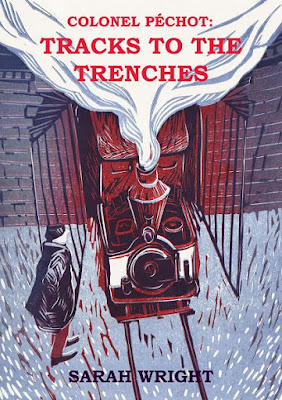 |
| This Péchot wagon, somewhat modified, was snapped at Apedale, Moseley Railway Trust. Though well over one hundred years old, the wagon relishes another day's work! |
You could build a kit, for your mantelpiece or for your 32mm railway, one of those prototypes you have seen at Apedale, the Festiniog or further afield, at Froissy for example.
As it happens, Wrightscale has just the wagon kit you need, the Péchot well wagon with bogies.
You may want to add a period crane. The modern one in the background of the above photograph, though fun, might spoil the ambiance of your model. Tantalising glimpses in contemporary photographs of the lamented Lynton and Barnstaple Railway suggest that they owned As it happens, Wrightscale have a model of a crane developed for military use. It would be just the thing for manouevring heavy but fragile objects on your layout!
Another import to Britain was Moelwyn. This started life as a Baldwin Gas Mechanical locotractor, another Wrightscale item, but was heavily re-engineered for life on the slate railways of Wales.
 |
| A Wrightscale Baldwin Gas Mechanical has been 'kit-bashed' by a customer |
Most, it has to be admitted, of British two foot/6ocm gauge was ex-War Department, found in Ashover, Snailbeach, the Ffestiniog and many other small commercial railways. The gauge proved to be surprisingly useful and adaptible - not a coincidence, I would argue. Wagons, as used by the British Army in World War One took various forms and were built in their thousands. Start with a Wrightscale WD bogie pair, and build it up as an open wagon, well-wagon, tanker wagon, workshop wagon or ambulance wagon. Research camouflage and paint!
 |
| This model was built by Jim Hawkesworth on Wrightscale WD bogies. |
FOR LOADS OF INFO - DRAWINGS, PHOTOS ETC
BUY A COPY OF MY BOOK - ON SPECIAL OFFER


Could someone please tell me the dimensions (or show me plans) of the freight wagons used at Ffestinog? They match those of the WW1 Trench 2-footers perfectly. I am in the US & am unable to find dimension information. Thank you very much.
ReplyDeletePeople in France & Great Britain seem much more familiar with the WW1 trench railroads (2-foot gauge) than those of us in the United States. I am unable to obtain the dimensions of the 4-wheel freight wagons (cars) used in the trenches (and still in use at Ffestniog. Could someone familiar with subject this please provide the measurements (or better yet -- detailed plans) of these wagons?
ReplyDeleteI will try again, although this site seems unwilling to take my e-mail address (which is: halrobert01@gmail.com ). I am the one repeatedly asking for the measurements (or even better- PLANS) of the WW1 2-foot gauge trench railway rolling stock. I live in the U.S., where there is very little information on these railways. Most North Americans don't even know they existed (even though Baldwin, Alco, Porter & American Car & Foundry supplied them). I have exhausted the Internet trying to find this information. Could some generous person supply this greatly-needed information?
ReplyDelete